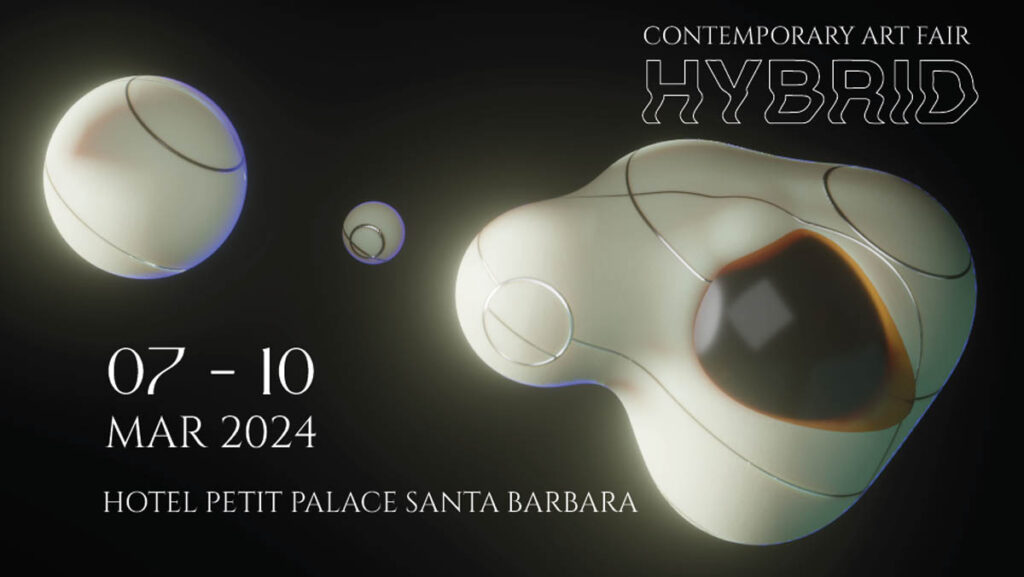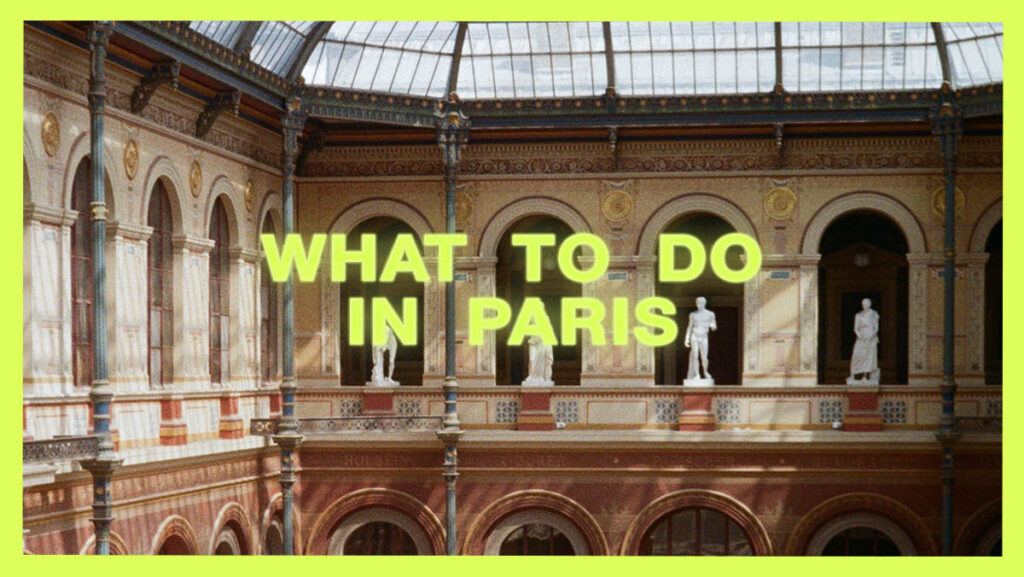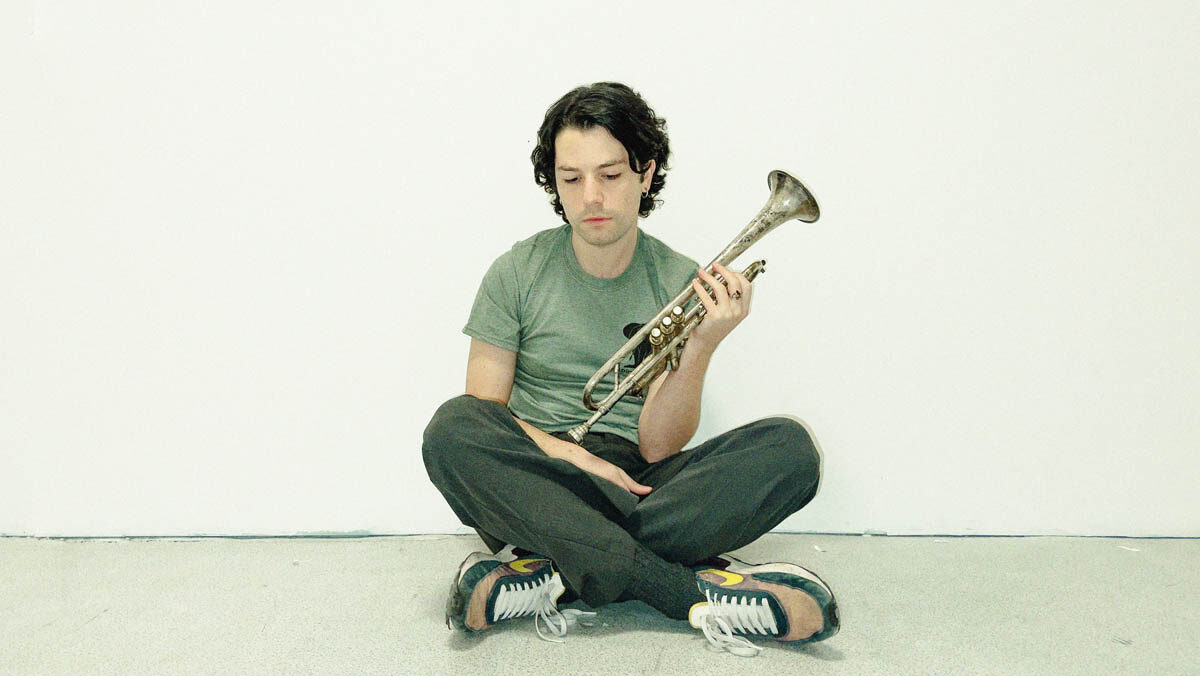
Composed of apocalyptic YouTube video fragments presented in a marine dreamlike sequence, the artist’s voice whispering words and lullabies, and the persistent sound of water flowing, Goodnight Goodnight manifests itself as a mercurial vision of the night of our times.
Trailer: Goodnight Goodnight
Currently, Pitzalis is exhibiting fragments of Corrisponeze Vol.1 at Palazzo Braschi, as part of the Quadrienale di Roma, sharing intimacies again. This time, in the form of nocturnal letters sent by him and to him.
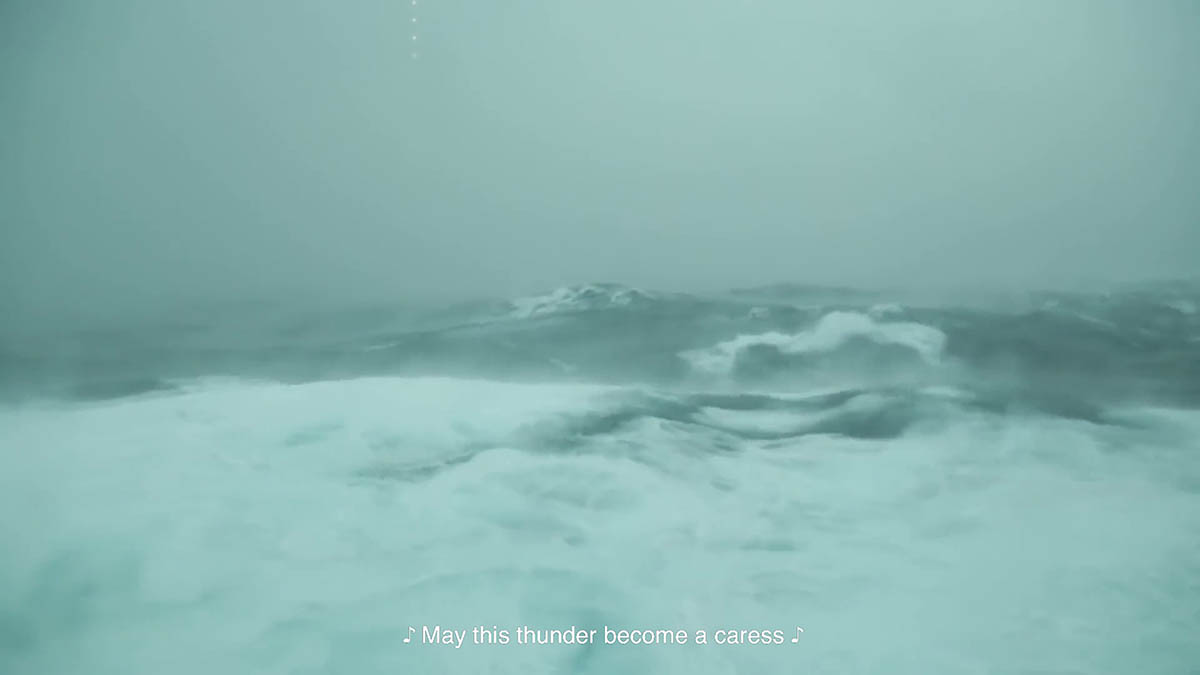
Luca Marcelli Pitzalis, Goodnight Goodnight, 2022, Video, HD, 11’45”, stille
Erka Shalari: Before delving into your artistic practice and art, I would like to go back to the times when you studied psychology in Rome. I am interested in what brought you to the field, and then how art came.
Luca Marcelli Pitzalis: Well, I guess I was interested in psychoanalysis, traumas, hidden truths, stuff like that. It was never about helping people to feel better, it was always about dealing with some kind of mystery. At that time, I was also starting to do my clumsy experiments with art. After graduating, I had to make a decision. I was afraid because I knew I had to leave everything behind and pursue art, but I didn’t know what kind of art I could do or if I was an artist at all. It was literally like jumping into the void. But deep inside, I knew where I belonged. I saw it a long time ago and I never lost the faith. During that period, I had a dream one night. The path was revealed, and a guide was offered. I made a deal and the journey began.
ESH: What was the dream about?
LMP: I understood that if I wanted to find my voice, I had to leave everything behind and jump into the unknown. In the dream, I was along a river, and a whale appeared. I can’t say exactly what happened, but I can tell you that it was a religious encounter, that left me with the most immaculate sense of wonder. I can still feel it. When I woke up, I said to myself “questa è la mia vita con l’arte” (“this is my life with art”). I knew what I had to do. I will follow the whale forever.
ESH: I would like to ask you about your connection with rituals, perhaps it is unexpected to you.
LMP: Not sure I have any rituals. I wear a silver ring that I bought the day before my first exhibition, and I never take it off. On my studio desk, I keep a quartz stone that my friend Delfina gave me before I left New York. Oh, I always buy a pack of Davidoff Gold for the openings of my exhibitions. I might have or do other things too. Things that protect me or make me be who I want to be.
ESH: What do you believe attributes to the profound resonance of the work The flag on the highest tower, leading to its frequent invitations for exhibition and capturing the attention of various curators?
LMP: I guess it’s because it evokes a feeling that everyone has felt at least once in their adult life. The desire to stop fighting and give up. A lot of people just want to give up. We all know why. It also has to do with the archetypical figure of the mother of course. But I think that the main reason why this work resonates with people is that the phrase „Mom can I come home?“ is very short. People remember it. On the other side of the flag, there’s a longer text. So it’s like a song: there are verses and there is a refrain. But what people remember is the refrain. In the oral tradition, stories were sung in verse and rhyme. In this way, they were easier to learn by heart. That’s how poetry was born, to remember the words. In Greek mythology, Mnemosyne, the goddess of memory, is the mother of the Muses, the goddesses of arts. Art keeps living and proliferates in people’s lives through memory. If you can repeat something in your head, you can keep it with you. It becomes an amulet or a magic spell.
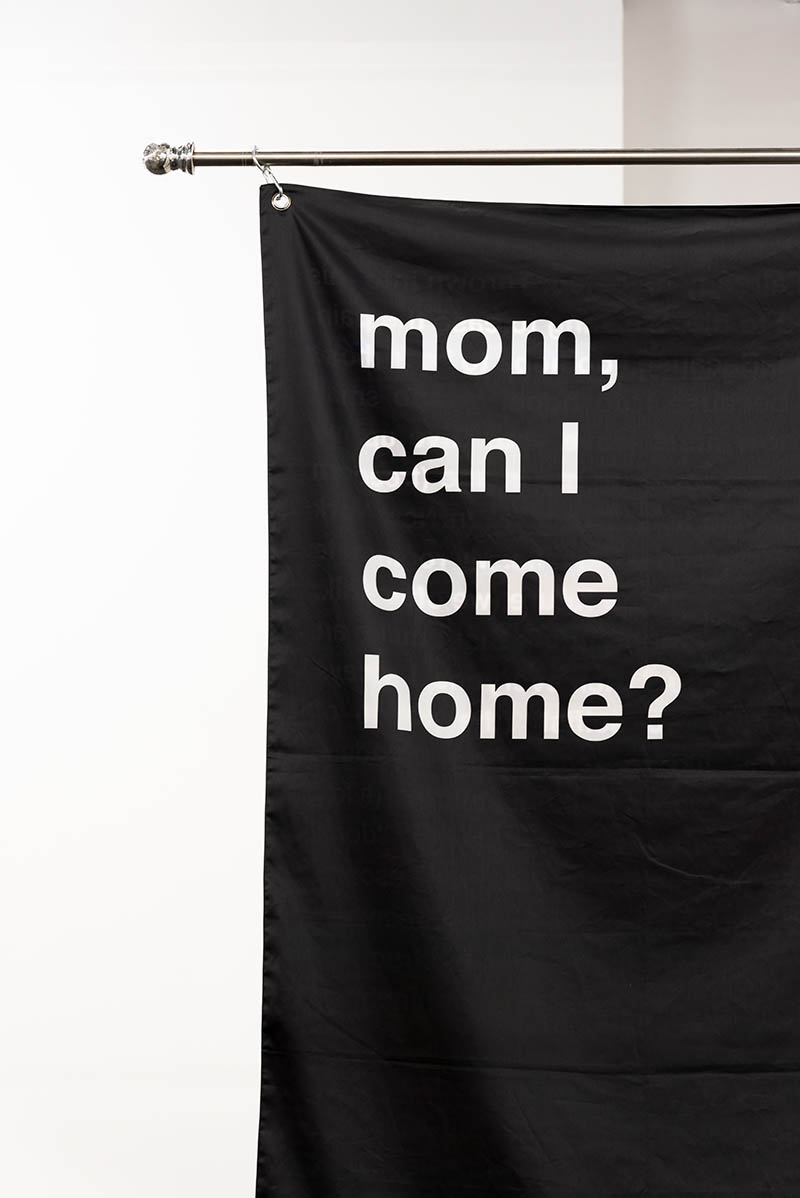
TLuca Marcelli Pitzalis, The flag on the highest tower, 2022, sublimation print on cotton satin. Dim: 150x100cm. Credits: Eleonora Cerri Pecorella 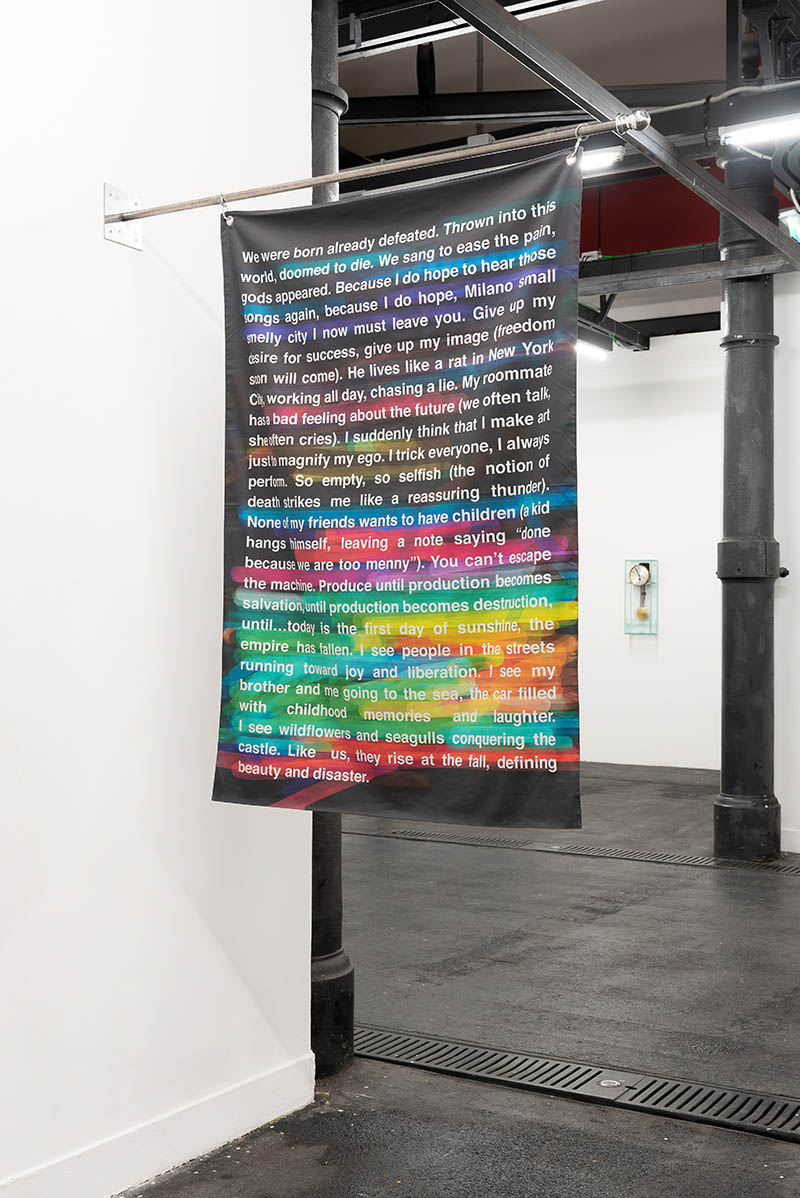
Luca Marcelli Pitzalis, The flag on the highest tower, 2022, sublimation print on cotton satin. Dim: 150x100cm. Credits: Eleonora Cerri Pecorella
ESH: How do your works emerge? Specifically, I would be interested to know how Evidence (in the dream I was hiding and the rain was falling down) was born? What significance did the incorporation of fictional elements hold for you?
LMP: Ideas usually come to me when I’m distracted. All the work is just preparatory work, cleaning the space for something to emerge. But then every work is different. About Evidence (in the dream I was hiding and the rain was falling down)… I don’t remember how it came to me, but I had this image of a city, with all the offices and corporate aesthetics, and uncanny and ancient feelings flooding it. Or the vision of being caught by the police and being asked to declare my intimate world, categorize the irrational.
This is what power does: define, predict, reproduce. They want to create an order so they can make a profit. They want to turn the night into an algorithm. But the night exists, and that’s where everything merges. Our intimacies, the past and the future, the inside and the outside, facts and imagination.
There’s the sound of police sirens, and mythologic sirens singing from the windows. There’s something a woman with schizophrenia said to me. Fragments of scripts and intimate revelations. A photo of Simone, my brother, on 6th Av. in New York, it was raining. There’s a dimension where everything coexists, so there’s no really a difference between what is true and what is not, between the public and the intimate, and so on. And sometimes, if you want to get somewhere, you have to take the opposite direction. If you want someone to tell you the truth, find someone who’s wearing a mask. Authenticity doesn’t mean much, because there’s no self.
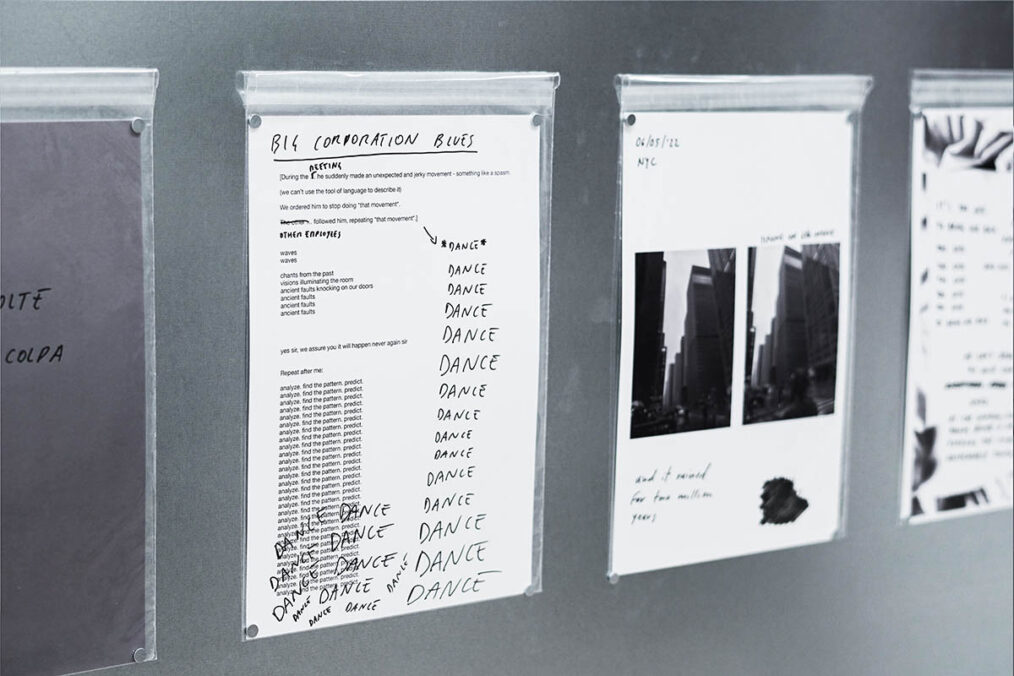
Luca Marcelli Pitzalis, Evidence (in the dream I was hiding and the rain was falling down), 2022, Inkjet print on paper, pigment pen, plastic bags, metal board. Dim: 100 x 200 cm. Credit: Lorenzo Placuzzi
ESH: Your current work Corrispondenze serves as a point of connection in this written dialogue. How did it develop?
LMP: When I started Corrispondenze, I didn’t know that it would become an actual work. It was just something that I wanted to do. The idea was to write intimate letters and send them to the people who wanted to receive them, and of course, invite them to reply. And that’s what I did for a year, every other Wednesday at 10 pm. Technically, Corrispondenze is a newsletter with 130 subscribers. In the summer of 2023, I exhibited it as Corrispondenze Vol. 1, which is an installation composed of fragments of some of those emails. It was part of a group exhibition curated by Ilaria Leonetti at the Italian Cultural Institute in L’Viv, Ukraine. And now is on view at Palazzo Braschi, in Rome, for my solo show with La Quadriennale di Roma, curated by Gaia Bobò. Maybe because I started it in New York, but for this work too I had the image of something intimate flooding corporate buildings, like in Evidence. There’s this line by Allen Ginsberg that I love: tenderness flowing through the buildings. I liked the idea of infiltrating the workspace of the email with something pathetically intimate, or just human (whatever it means). I also wanted to do something that didn’t look like art, something that was just (…), something that happens. Like everything else happens. I’m set to do what many people before me tried to do: to merge art and life. I believe that the ultimate goal is the „artistic life“, not art itself. Duchamp said that. Art is the product of artistic lives. So, the real work is the journey of becoming an artist, which is the journey of creating yourself. To be free. To free yourself from everything. Also from art. Free yourself from the desire to be an artist, from the production of art. You can live an artistic life and not be making art. As I said, if you want to get somewhere, you have to take the opposite direction sometimes.
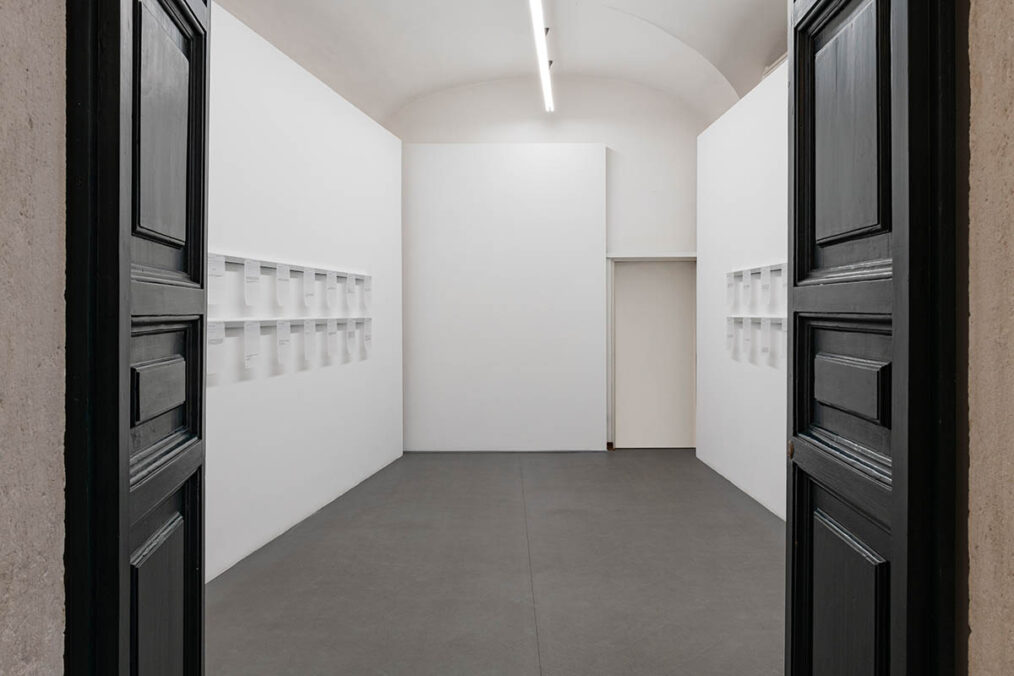
Luca Marcelli Pitzalis, Correspondences Vol.1, 2023 newsletter, 36 prints on semi-transparent matte A4 paper, aluminum guides, magnets, environmental dimensions. Museo di Roma, Palazzo Braschi. Ph: Courtesy Fondazione La Quadriennale di Roma, foto Carlo Romano
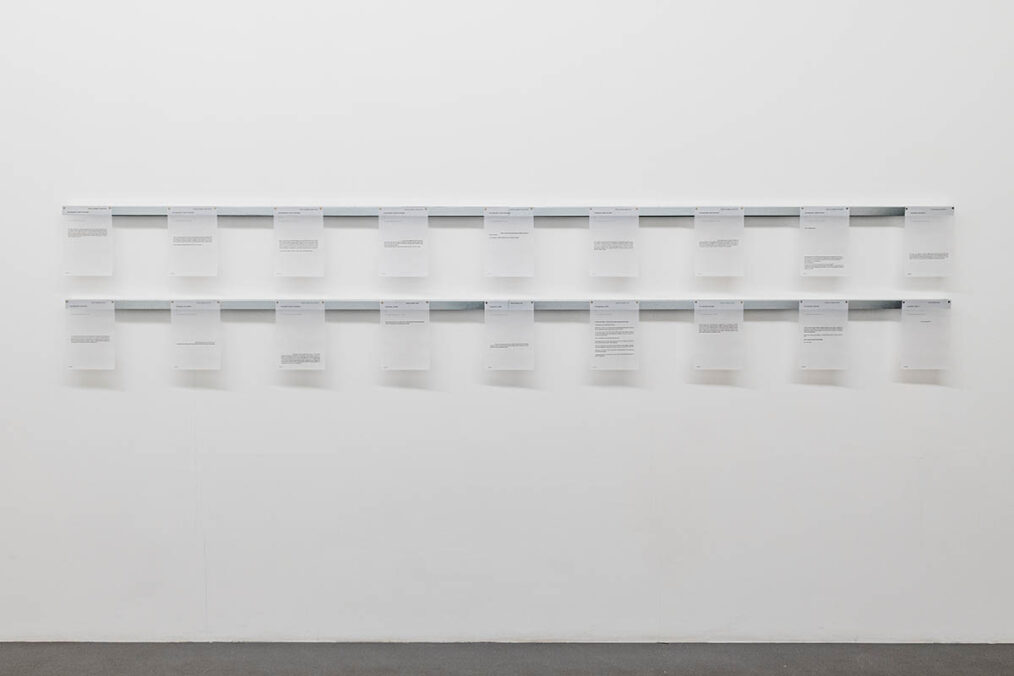
Luca Marcelli Pitzalis, Correspondences Vol.1, 2023 newsletter, 36 prints on semi-transparent matte A4 paper, aluminum guides, magnets, environmental dimensions. Museo di Roma, Palazzo Braschi. Ph: Courtesy Fondazione La Quadriennale di Roma, foto Carlo Romano
ESH: I think some of the most touching messages for me have been the girl living in Turin, who had changed the colour of her hair, who had left a relationship that probably was not doing good anymore, then was nice the person who had bought an amulet for Marie (if I remember well the name), but that started to love it for herself and as a consequence started to feel torn. Then you, on one August night, dreaming about a new world after the first day of the sea for the year.
LMP: I love the amulet’s story. It’s also one of my favorites. The person who wrote it is the first person I became friends with when I first arrived in Milano and we are still friends. She gave the amulet to Marie eventually. Maybe the universe would have punished her if she kept it.
ESH: How are the letters of the Correspondences sequenced in Quadriennale? If we read them all, could we say that they are shared things between the individuals that you have been corresponding?
LMP: The letters are placed in chronological order. You can read the date and the time on them. I took the sender and the receiver out, so it’s like just one choral subjectivity talking. This is connected to the work’s nocturnal nature. I don’t know if there’s any shared or recurrent theme. Maybe a sense of anxiety or tiredness. But what I see it’s just tenderness.
We are all thrown into this world, bound to die. If you carefully think about it, it’s so cruel that makes you want to scream and jump off the window or go to sleep forever. So every attempt to find some kind of beauty, or be happy, or build something in the face of the imminent disaster, or every attempt to just have a decent life, just going to work or smiling or trying to be kind, is infinitely tender and a wonderful miracle.
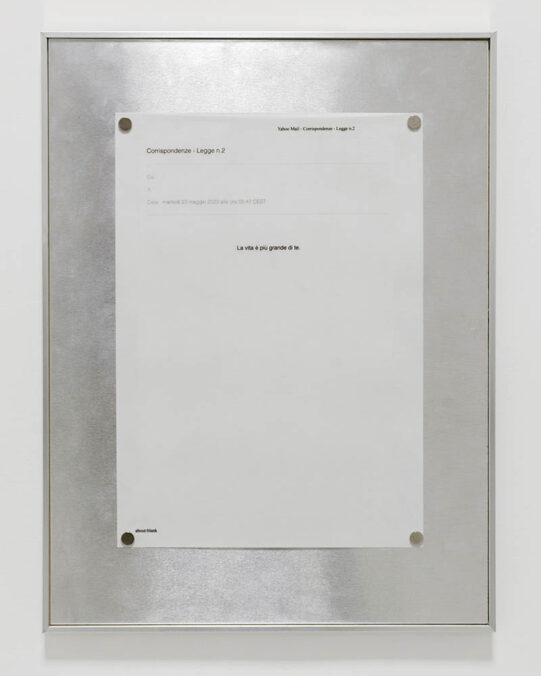
Left: Luca Marcelli Pitzalis, Corrispondenze Vol.1_#36, 2023, print on semi-transparent matte A4 paper, aluminum sheet, magnets, framed, 30x40cm. Right: Luca Marcelli Pitzalis, Corrispondenze Vol.1_#4, 2023, prins on semi-transparent matte A4 paper, aluminum sheet, magnets, framed, 30x40cm. 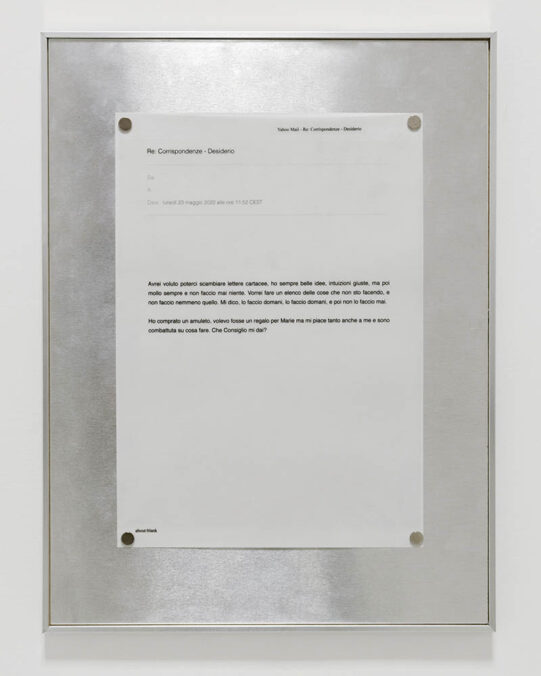
Left: Luca Marcelli Pitzalis, Corrispondenze Vol.1_#36, 2023, print on semi-transparent matte A4 paper, aluminum sheet, magnets, framed, 30x40cm. Right: Luca Marcelli Pitzalis, Corrispondenze Vol.1_#4, 2023, prins on semi-transparent matte A4 paper, aluminum sheet, magnets, framed, 30x40cm.
ESH: When witnessing a few works of yours, one pretty fast realizes that voice is a crucial element in your work, and I find it interesting how you use it – like at Goodnight Goodnight, you whisper from under a blanket, at So Long and Thanks you place the speakers on the top of a door, between inside and outside. Also, in your artistic statement, you talk about this tension. Can you say something more on that?
LMP: There are many books about the voice as a bodily and sonic matter more than the house of language and meaning. It’s the old battle between Logos and Phonè, the mind and the body, God and Evil, and so on, the voice is in the middle and nowhere at all. I studied all the books but the artists who translate that stuff into practice are often boring as hell. I just try to be sincere. I only use my voice when I have something true to say or sing. And if you are sincere, that truth will be found in the sound of your voice. And truth can only be found in the sound of a voice. A singer must die for the lie in his voice!
ESH: In the last years, after you left Milan or maybe after you were preparing to leave, you have been in various places such as NYC, Buenos Aires. What is next geographically and artistically?
LMP: I’m working on a music album composed of voice recordings. I want it to be just traces of people who are alive now and will be dead one day, with all the cracks in our existence and all the cracks in our voices. It will be very rough, like a rehearsal, very direct, I want to get rid of almost everything. I’d like to do a kind of art that anyone can relate to, or even do, everywhere, all the time, something that you can keep with you, something that protects you and transforms your life. A kind of art that can adapt to changes and anyone’s life. Something that I can do even if I have a corporate job that steals all my time, even if I can’t afford a studio, even if I’m forced to be part of society’s production gears. Something that relates to all of this, and helps to transcend it. I spent a few months in Buenos Aires with my girlfriend Isabella, who lives there. Now she’s moving to London and I’ll move to Berlin in March (still looking for an apartment/room, if some readers want to help lol), and I’ll go back to New York for a residency later this year. It’s all very temporary, very precarious, money-wise especially. You have to be crazy to keep working as an artist in your adult life.
But I know that I have to keep walking, and whatever happens, even if the sky should fall, I’d still have my voice left. There’s always a song to sing to someone, and there’s always someone to sing a song to.
Editorial notes:
1. Luca Marcelli Pitzalis’s work can be currently seen at Quadriennale Di Roma, Palazzo Braschi, Piazza Navona 2, Rome. Exhibition duration: 22 December 2023 – 21 January 2024.
2. Correspodences Vol.1 has been kept as has happened in the Italian language. While the email’s subject may vary, the revelations within each individual’s writing appear to share a common thread in my perception. Subjects from the letters: Prima luce, Desiderio, Solo vita che schorre, Un giorno in pieno agosto (…)
Luca Marcelli Pitzalis was born in the summer of 1995 on the island of Sardinia, Italy. He lives and works in Italy. LMP works in a wide range of media including installation, audio, video, performance, writing, and songwriting. His research explores the dimensions of intimacy and sensitivity in the infosphere. A countermelody of vulnerability and defeat arises from his works, as opposed to the translation of human experience into data, and to the dominance of the paradigms of growth and productivity. Luca Marcelli Pitzalis’s universe is made up of night email exchanges with his newsletter’s subscribers, autobiographical stories between fiction and reality, flags of hope and despair, words and songs whispered to the wind. – www.lucamarcellipitzalis.com
The Quadriennale di Roma is the national institution entrusted with the task of promoting Italian contemporary art in Italy and abroad. – www.quadriennalediroma.org, www.quadriennalediroma.org/en/quadriennale_exhibitions/
Erka Shalari is an art writer and editor. Her work is committed to uncovering distinctive artistic positions in contemporary art. The work methodology is strongly influenced by psychology, epistemological works, as well as affects and rituals. The individuals following each interview are intertwined with a file rouge not only with the writer but also with one another, creating so curated series and episodes.




